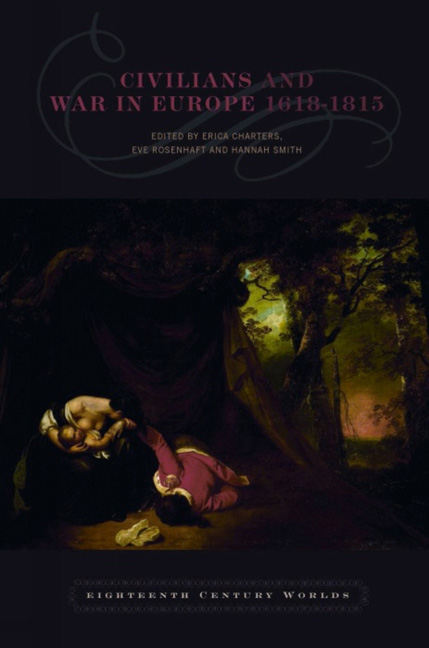Book contents
- Frontmatter
- Contents
- List of Contributors
- Acknowledgements
- List of Illustrations
- List of Abbreviations
- 1 Introduction
- Part I Suffering, Reconciliation and Values in the Seventeenth Century
- Part II The State, Soldiers and Civilians
- 6 The Administration of War and French Prisoners of War in Britain, 1756–1763
- 7 Civilians, the French Army and Military Justice during the Reign of Louis XIV, circa 1640–1715
- 8 Restricted Violence? Military Occupation during the Eighteenth Century
- 9 British Soldiers at Home: The Civilian Experience in Wartime, 1740–1783
- Part III Who is a Civilian? Who is a Soldier?
- Part IV Contradictions of the French Revolutionary and Napoleonic Wars
- Bibliography
- Index
8 - Restricted Violence? Military Occupation during the Eighteenth Century
from Part II - The State, Soldiers and Civilians
- Frontmatter
- Contents
- List of Contributors
- Acknowledgements
- List of Illustrations
- List of Abbreviations
- 1 Introduction
- Part I Suffering, Reconciliation and Values in the Seventeenth Century
- Part II The State, Soldiers and Civilians
- 6 The Administration of War and French Prisoners of War in Britain, 1756–1763
- 7 Civilians, the French Army and Military Justice during the Reign of Louis XIV, circa 1640–1715
- 8 Restricted Violence? Military Occupation during the Eighteenth Century
- 9 British Soldiers at Home: The Civilian Experience in Wartime, 1740–1783
- Part III Who is a Civilian? Who is a Soldier?
- Part IV Contradictions of the French Revolutionary and Napoleonic Wars
- Bibliography
- Index
Summary
A HISTORY OF OCCUPATION AS A HISTORY OF THE RATIONALISATION OF WAR
MILITARY OCCUPATION as a phenomenon plays a paradigmatic role in any analysis of the relationship between civilians and war as a situation where the military's interaction with the civilian population is at its most overwhelming. It also provides, through comparative examples of military occupation, a means by which we can identify lines of development in regulating civil–military relations. If the eighteenth century is particularly prominent in this chapter, it is because this period can be seen as a culmination of early modern developments, insofar as the various experimental approaches of the late sixteenth and, above all, seventeenth centuries appeared to now be systematised in practice – as well as being reflected in ‘classical’ European international law. For the most part, these standards still applied to the wars waged by nineteenth- and twentieth-century European states and, in this respect, can be viewed as something of an early modern achievement.
This chapter thus argues against the frequently expressed view that military occupation has been a transhistorical feature of war since ancient times. Those who advocate such a view rarely make a clear distinction between military occupation, conquest and domination by a foreign power. By contrast, this chapter insists on the historically specific character of military occupation in the context of continental European warfare. It had ancient and medieval precursors, but military occupation as a specific complex of practices only came to be realised in the early modern period, because that is when the decisive preconditions were available. Occupation requires an orderly administration of the extraction of resources, and this makes it at once an index and a component of the ‘bureaucratisation’ or rationalisation of war. This in turn requires that distinctions be drawn between combatants and non-combatants. Both preconditions were first realised in the early modern period, though always within limits.
- Type
- Chapter
- Information
- Civilians and War in Europe 1618–1815 , pp. 118 - 128Publisher: Liverpool University PressPrint publication year: 2012

